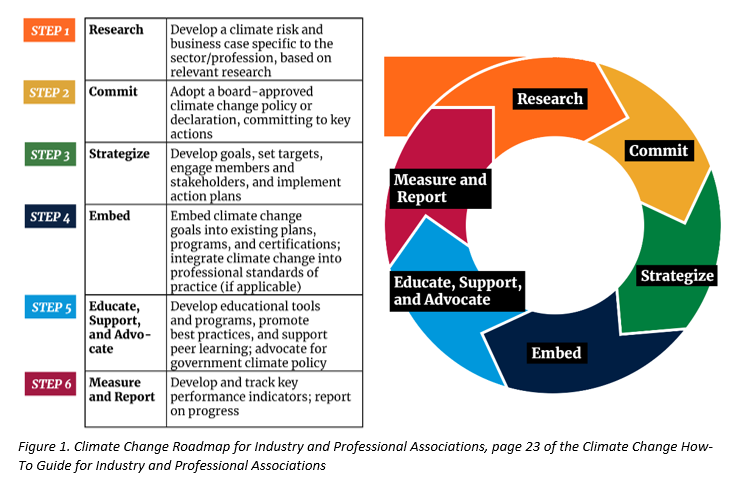How Your Association Can Lead in the Fight Against Climate Change

Back in 2019, scientists around the world amplified their call to action by declaring “clearly and unequivocally” that our planet is facing a climate emergency. Their key message: without immediate and forceful action to reduce greenhouse gas emissions in the next ten years, our planet’s climate could reach a tipping point, making global warming irreversible in human timescales. In Canada, where temperatures are warming twice as fast as the global average, this would result in frequent and severe climate impacts, causing large-scale disruptions to economic stability and trade, damaging supply chains, reducing food and water security, and threatening the health and well-being of Canadians, especially vulnerable populations.
So, how do we avoid this catastrophic scenario and minimize impacts on our businesses, infrastructure and communities?
The safest option for humanity to avoid this scenario is to limit global warming to 1.5 degrees Celsius. Unfortunately, we are currently on track to reach a global temperature rise of 3 – 4ºC by the end of the century. To achieve 1.5ºC, we would need to reduce greenhouse gas emissions by 45% below 2010 levels by 2030 and reach net zero emissions by 2050. Regardless of how much we emit in the future, we must also increase our resilience and prepare for the inevitable impacts of a changing climate. Most importantly, action to reduce emissions and prepare for climate change must be taken collectively and in a coordinated manner, involving government, civil society and every professional and industry sector.
This is where industry and professional associations fit in.
Industry and professional associations – with their broad-based memberships – are central to this work. Your association has a role to play in preparing your members for the impacts of climate change and orienting your sector or profession towards a low-carbon future.
Not only does this help your members reduce climate-related risks, it also allows your association to draw on the significant opportunities that come from addressing these challenges. For example, associations which respond to and act on prevailing societal trends will strengthen their sector or profession’s credibility and relevance in the eyes of their members and society, and are better able to attract and retain members and employees. Other co-benefits of taking action on climate change include opportunities to enhance innovation, save costs and open low-carbon market opportunities. Not only this, but associations that collaboratively engage with government on climate change policy and proactively adopt climate change best practices are able to prepare for government climate regulations and drive policy in their favour.
When we [Forest Products Association of Canada] did our 30 by 30 Climate Change Challenge, we proposed new policy and regulation – we didn’t wait for it. If you have a plan, the government is open to discussing the changes you’re suggesting. That proactiveness was significant for us and for our members.
Bob Larocque, Senior Vice President, Forest Products Association of Canada
Associations which promote and implement cutting-edge climate change practices, programs, and solutions are seen as leaders in their sector or profession in Canada and around the world. This is an opportunity to help your members see themselves as part of the solution to climate change and position them to succeed in a low-carbon future.
How associations can help their members prepare for climate change
If you’re looking for a comprehensive climate change tool to help your association with this task, you’re in luck. Earlier this month, the Climate Change How-To Guide for Industry and Professional Associations was released by the British Columbia Council for International Cooperation (BCCIC), which was produced for just this purpose.
The Climate Change How-To Guide for Industry and Professional Associations is a treasure trove of resources, best practices and steps associations can pursue to help their members respond to the climate crisis – and make sure they are future-fit. It includes an interactive benchmark tool that associations can use to rank themselves and see how current efforts stack up. It pinpoints gaps that can be addressed through climate change action plans.
In the Guide you will also find a business case for climate action, barrier-busting strategies, and a roadmap to put your association on a positive path (see Figure 1). The Guide’s content was developed through consultation with over 30 industry and professional association representatives and subject matter experts.

Top 10 Climate Change Focus Areas for Associations
- Research and Knowledge Development. A comprehensive knowledge-base is an essential starting point. Your association and your members should be up-to-speed on the expected physical and transition risks and opportunities of climate change. This is essential for an informed, coordinated response.
- Professional Development and Education. With relevant information at hand, associations can begin to educate members on the climate change trends, risks, and opportunities relevant to the sector or profession and how to address them.
- Standards and Certifications. Whether voluntary or mandatory, these can help to incentivize action. Some trade and many professional associations have standards and certifications that can be upgraded to include climate change competencies and practices. Standards are an effective tool for aligning your association’s members on common best practices.
- Best Practices, Resources and Support. Solutions to climate change exist already – profile existing best practices of your members and facilitate knowledge sharing and peer learning to promote innovative ideas and action within your membership.
- Policy and Planning. Aspirational goals, concrete plans and engaged boards, staff and members are needed to successfully respond to climate change. Once association staff and members have a shared understanding of the importance of addressing climate change, it becomes possible for the association to develop policies, plans and goals for you and your members to pursue together.
- Monitoring, Evaluation and Reporting. Success only comes with strong metrics. Once goals and plans are established, you can develop metrics to track and even publicly report on your success.
- Marketing and Public Engagement. Build and promote the brand or value of your profession/sector to key audiences and help the public, industry and governments advance together on climate change.
- Government Relations. Drive government climate policy – don’t wait for it. Include climate advocacy in your government relations efforts.
- Collaboration and Partnerships. Collaboration and partnership with government, civil society, academia and industry are essential to address interdisciplinary issues such as climate change. Sectors and professions will need to collaborate and co-innovate with allied associations to overcome barriers and accelerate the transition.
- Operational Practices. Lead by example from within the association and achieve cost-saving benefits by adopting internal climate measures. Consider whether becoming carbon neutral is a reasonable target for your association to be a role model and inspire other stakeholders.
By following the steps in the Climate Change Guide, you will be able to help your members become climate change leaders, play their role in the transition to a low-carbon economy, reduce greenhouse gas emissions and increase their resilience in the face of climate change. It is becoming increasingly clear that those who are prepared for climate change will succeed in the future, and those who delay put their organizations and clients at risk. Associations play a critical role to help members with this transition.
The time to act is now.
The year 2020 marks a pivotal moment in human history. As the world is overcome by the devastating COVID-19 pandemic, human health and the economy arise as paramount priorities. On top of this global emergency, the widespread outcries against systemic racism turn thoughts towards ongoing social inequities which remain entrenched in modern society. 2020 also initiates the 10-year countdown before the effects of climate change – which could easily develop into the world’s largest health and economic crisis – become potentially irreversible. While on the surface, these challenges seem distinct and unrelated, both the pandemic and systemic racism are intrinsically linked to the present and future impacts of climate change. Climate change has a disproportionate impact on low-income and communities of colour, and only exacerbates entrenched social inequity and the impacts of COVID-19.
As the world recovers from the pandemic and comes to terms with deep-rooted social inequities, how can we put climate change back on the radar? Well, there are opportunities for transformative change that only exist in the window of a disaster. Many governments and businesses are pursuing a response that supports an equitable transition towards a resilient, low-carbon economy. Now, more than ever, industries and professional groups can capitalize on this pivot in ways that will benefit their members and society for years to come.
Download the full Climate Change Guide and Interactive Scorecard for free on BCCIC’s website, here: https://www.bccic.ca/climateguide/
Here’s what association leaders say about the need for action and how the Climate Change Guide for Industry and Professional Associations can help:
“I truly believe that since associations can set a direction and policy for their members that extends far beyond profit margins and political timelines, that we can – and must – play a leading role in advancing climate change solutions. Professional associations and their members have a responsibility to act on climate change, not only because stakeholders are demanding it, but because it is the right thing to do. BCCIC’s Climate Change Guide for Industry and Professional Associations can help associations develop and advance their climate change practices to fulfill that responsibility and create lasting value for their members.”
Beth McMahon, Chief Executive Officer, Canadian Institute of Planners
“Taking initiative on climate change shows leadership to members and stakeholders, demonstrating that the sector wants to contribute to solutions that will benefit society as a whole. This leadership position can create value for members, and even recruit new members who are looking for guidance as they navigate climate change impacts and trends. This Guide is a great resource for any industry or trade association, large or small, who wants to start or enhance their climate change initiatives to help their members succeed in a warming future”.
Paul Lansbergen, President, Fisheries Council of Canada






















